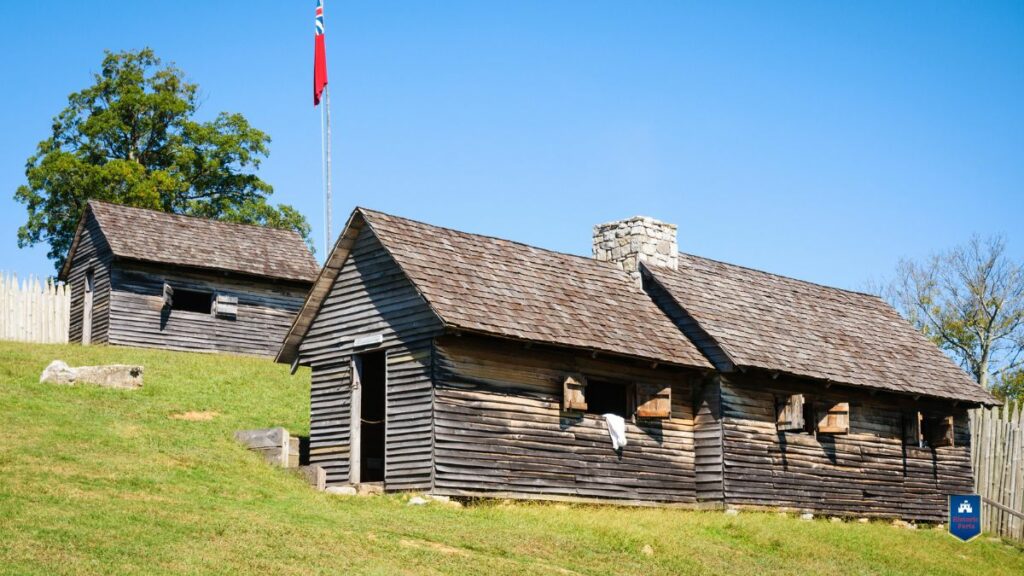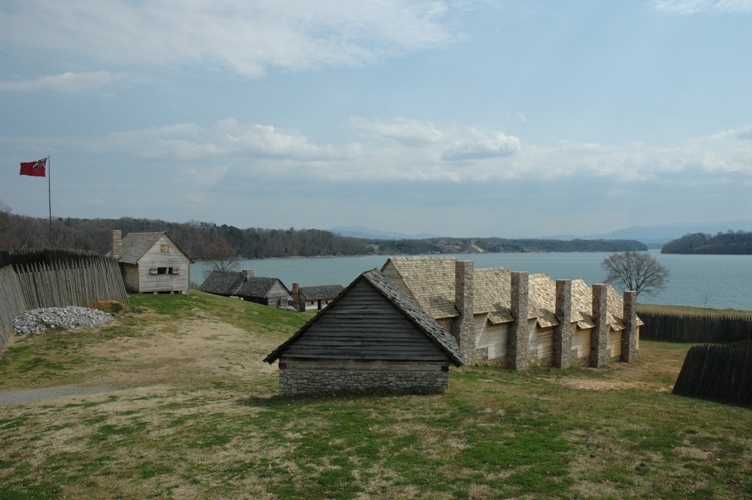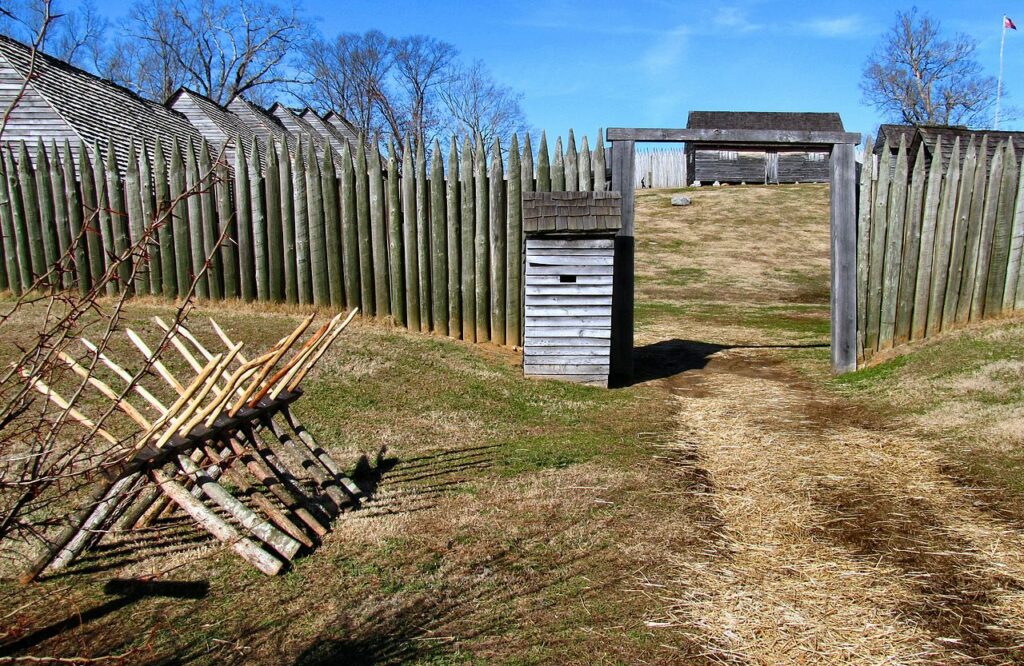Fort Loudoun State Historic Park offers a captivating journey into Tennessee’s frontier history. Established in 1756, the park showcases the British’s strategic military and diplomatic efforts in the mid-18th century.
Visitors can explore the reconstructed fort, engage with living history exhibits, and learn about the complex interactions between the British and the Cherokee Nation.
The park’s scenic location in the Appalachian Mountains and along Tellico Lake provides a picturesque backdrop for hiking, picnicking, and educational programs.
With its rich historical significance and diverse activities, Fort Loudoun State Historic Park is a must-visit destination for history enthusiasts and nature lovers alike.
History of Fort Loudoun

Fort Loudoun State Historic Park has a rich history in the mid-18th century.
This reflects its role in early American frontier defense and interactions with Native American tribes. As a crucial British establishment, it influenced trade, warfare, and diplomacy in the region.
Establishment of Fort Loudoun
Fort Loudoun was established in 1756 as part of the British Colony of South Carolina’s efforts to counter French influence in the area. The fort’s strategic location aimed to protect settlers and strengthen alliances with the Cherokee Nation.
Built mainly by the Independent Company of South Carolina, it became one of the earliest British fortifications in Tennessee.
Constructed near the Overhill Cherokee towns, its primary materials included timber and earth. Designed to house soldiers and supplies, Fort Loudoun was vital during a period of intense colonial expansion and competition.
Today, it is a focal point for understanding colonial military strategies and interactions with indigenous populations.
Role in the Indian Wars and Western Frontier
Fort Loudoun played a significant role in the Indian Wars, particularly during the Anglo-Cherokee War (1758-1761). The fort responded to rising tensions and conflicts between the British settlers and Cherokee allies.
As hostilities escalated, it became a critical defense point against potential Cherokee attacks.
Its fall in 1760 marked a turning point in British-Cherokee relations. After a siege, weakened supply lines and increasing hostility led the garrison to surrender to the Cherokee.
This event underscored the importance of the fort and the volatility of frontier politics and alliances during the period.
Fort Loudoun and the Overhill Cherokee Nation
The relationship between Fort Loudoun and the Overhill Cherokee Nation was complex. Initially, the fort represented a cooperative effort, serving as a hub for trade and diplomacy.
The 18th-century Trade fair held at the site commemorates these early exchanges and highlights the fort’s role in regional commerce.
However, as tensions grew, Fort Loudoun’s presence strained Cherokee-British relations. The Cherokee’s eventual surrender and destruction of the fort in 1760 were emblematic of the broader conflict between Native American tribes and European settlers.
This dynamic illustrates the shifting alliances and the fort’s strategic importance in colonial-era politics.
Fort Loudoun State Historic Park is now a National Historic Landmark, preserving the memory of these interactions and the fort’s historical significance.
Visitors can explore reconstructed elements and learn about the fort’s impact on the region’s history.
Park Features and Amenities

Fort Loudoun State Historic Park offers fascinating features and amenities that cater to history enthusiasts and visitors seeking leisure activities.
Reconstruction and Living History Exhibits
The reconstructed fort vividly represents the colonial fort built during the Great Depression. Living history exhibits bring the past to life, with staff dressed in period costumes demonstrating 18th-century crafts and military exercises.
Special events often feature reenactments that showcase the daily life and routines of the fort’s original inhabitants, offering visitors an immersive experience of the fort’s Living History.
Fort Loudoun State Historic Area
The historic area includes the reconstructed fort and interpretive trails that outline the area’s history. Informative markers detail significant aspects of the fort’s role in colonial America.
Visitors can explore the well-preserved landscape that contextualizes the fort’s strategic position.
This area offers a serene environment, perfect for those looking to understand the historical significance while enjoying a tranquil setting.
Visitor Center and Educational Resources
The Visitor Center serves as the hub for educational outreach, equipped with exhibits, a small museum, and an informative 15-minute film about the fort’s reconstruction.
Displays cover various aspects of the fort’s construction, military strategy, and daily life.
Educational programs and workshops are regularly held, catering to school groups and history buffs keen to learn more about this critical site in early American history.
Recreational Areas and Picnic Facilities
Picnic areas are scattered throughout the park, allowing visitors to relax and enjoy the picturesque surroundings.
These areas have tables and grills, making gathering convenient for families and groups.
The park also features hiking trails and spaces for various recreational activities, ensuring that all visitors can enjoy Fort Loudoun State Historic Park’s historical and natural beauty.
Activities and Events

Fort Loudoun State Historic Park offers various activities to engage visitors of all ages.
Educational Programs and Seasonal Festivities
The park hosts Monthly Interpretive Programs highlighting different aspects of 18th-century life.
These programs often include demonstrations of colonial crafts, guided tours of the fort, and historical reenactments.
Educational workshops tailor experiences to school groups, providing hands-on learning opportunities.
Popular Seasonal Events are a significant draw. Events like the 18th Century Trade Faire transport visitors back in time, showcasing authentic trading practices, period-appropriate entertainment, and traditional food.
The park offers themed holiday activities, including candlelight tours and festive decorations displaying colonial-era celebrations.
Year-round Events
Several year-round events ensure there’s always something happening at the park.
The fort conducts regular living history weekends, where reenactors bring the fort’s history to life.
Special presentations on colonial military tactics, daily life, and traditional skills are regular features.
The park also organizes nature hikes and bird-watching sessions, allowing visitors to explore the natural beauty surrounding the historic site.
The park features guest speakers and special exhibits throughout the year, adding depth to the visitor experience.
Explore More: Army Forts in Tennessee
Natural Surroundings and Geography
Fort Loudoun State Historic Park is located within the Appalachian Mountains and offers scenic views and diverse natural features.
The park encompasses a 1,200-acre site at the banks of Tellico Lake and the Tennessee River Valley, creating an ideal environment for various outdoor activities and ecological preservation.
Appalachian Mountains and Tennessee River Valley
The park lies in the heart of the Appalachian Mountains, providing a stunning backdrop with lush greenery and rolling hills.
The Tennessee River Valley runs adjacent to the park, contributing rich soil and a diverse ecosystem.
Visitors can explore trails that wind through dense forests and meadows, offering opportunities to observe local wildlife.
The elevation changes in this region create a dynamic landscape that appeals to casual hikers and nature enthusiasts.
Tellico Lake and Reservoir Overlooks
Tellico Lake, formed by the damming of the Little Tennessee River, is a central feature. It spans several thousand acres and provides recreational opportunities like boating, fishing, and swimming.
Several overlooks throughout the park offer panoramic views of the lake and surrounding landscape.
These vantage points are perfect for photography and provide serene spots to appreciate the park’s natural beauty.
The lake’s clean, calm waters and the surrounding forest create an idyllic setting for visitors.
Explore More: 21 Historic Forts of Tennessee
Visitor Information
Fort Loudoun State Historic Park is an important heritage site with specific details visitors need to know. These include hours of operation, amenities available at the park, and how to access park maps and guides for a better experience.
Operating Hours and Admission
The park is open daily from 8:00 AM to 4:30 PM. The Park Office and the Gift Shop operate on the same schedule, making it convenient for visitors to acquire necessary information or souvenirs.
Admission to the park is free of charge, although donations are appreciated. The historic site is popular, so expect more visitors during holiday weekends and summer months.
Park Map and Guide Availability
Visitors can acquire a comprehensive park map and guide at the Park Office or online.
The map details all key locations within the park, including historical points of interest, walking trails, and restroom facilities.
These guides are available free of charge. They help guests navigate the park with ease and gain insights into its historical significance.
Amenities and Accessibility
The park has various amenities to enhance visitor experience, including picnic areas, restrooms, and a Gift Shop.
Picnic areas are equipped with tables and BBQ grills.
Restrooms are accessible and well-maintained, located near main pathways.
The Gift Shop offers a range of souvenirs and educational materials.
The park strives to be accessible to all visitors, with paved paths and ramps to accommodate wheelchairs and strollers.

Cory is a website owner and content creator who enjoys fishing, history, coin collecting, and sports, among other hobbies. He is a husband and father of four.
Romans 15:4 For whatever was written in former days was written for our instruction, that through endurance and through the encouragement of the Scriptures we might have hope.

